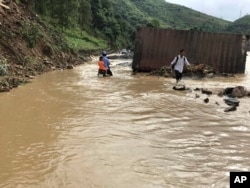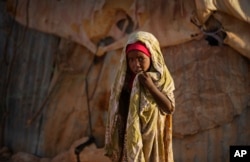Climate change threats, from worsening drought and flooding to sea level rise, could increase the risks of hunger and child malnutrition around the world by 20 percent by 2050, food security researchers warned Wednesday.
But looking carefully at the very different risks facing each country, region and type of food producer — from highland rice farmers in Cambodia to cattle herders in South Sudan — could help reduce that threat of growing hunger, they said.
In North Africa, for instance, both herders and farmers face fast-growing risks from more frequent, longer and more intense heatwaves and declining water availability, while population growth and greater urbanization could also hit food security, according to a report by the World Food Program (WFP) released Wednesday at the U.N. climate talks in Bonn.
In South Asia, by comparison, dense populations of farmers face threats from worsening floods, cyclones and droughts, as well as long-term threats to the stability of monsoons and water flow in glacier-fed rivers.
“Different groups are affected by different types of risks, at different intensities and at different times,” said Gernot Laganda, the director of climate and disaster risk reduction programs at WFP.
Building greater resilience to the threats will require “layers” of responses, he said.
Catastrophic threats of large-scale losses of crops or animals — the type that might come along every 5 to 10 years, for instance, and force those hit to migrate — might be dealt with in part with insurance plans, Laganda said.
But more regular seasonal threats — of smaller-scale flooding, for instance — cannot be insured, he said, as the problems come too frequently.
In those cases, building savings groups among women farmers, for instance, to ensure cash is on hand to deal with the crop failures, could be a better way to deal with risks.
The report aims to give country governments, and food security organizations, a clearer and more specific look at the threats they face, and better tools to deal with them. It looks in detail at particularly threatened regions, including parts of Africa and Asia, and at 15 specific countries, from Afghanistan to Mali.
One surprise from the work, Laganda said, is that it was not always the poorest countries that were most vulnerable to hunger threats.
“Sometimes we assume middle-income countries have a much easier time ... which is not necessarily the case,” he said.
South Asia, in particular, has big numbers of hungry people, he said and overall “the largest vulnerabilities to loss and damage in food systems occur in Asia.”
In Africa, drought is the biggest threat to hunger levels, but conflicts also play a big role, he said.
Laganda said such differences need a careful look if countries and food security agencies are to better manage coming climate threats and achieve the international goal of ending hunger by 2030, one of a set of so-called Sustainable Development Goals.
“We are not going to achieve zero hunger by 2030 if we do not factor climate-related shocks and stresses into our equation,” he warned. “Climate needs to factor into food security discussions ... at a country level in a much bigger form than it does now.”
And aid agencies like WFP “as much as governments” need to focus more on risk management, he said.
Mikael Eriksson, who works on climate, energy and environmental issues for Sweden’s government, said the growing complexity of humanitarian disasters requires innovation and rethinking old ways of doing things.
“Prevention is so much more efficient than disaster management,” he said.










